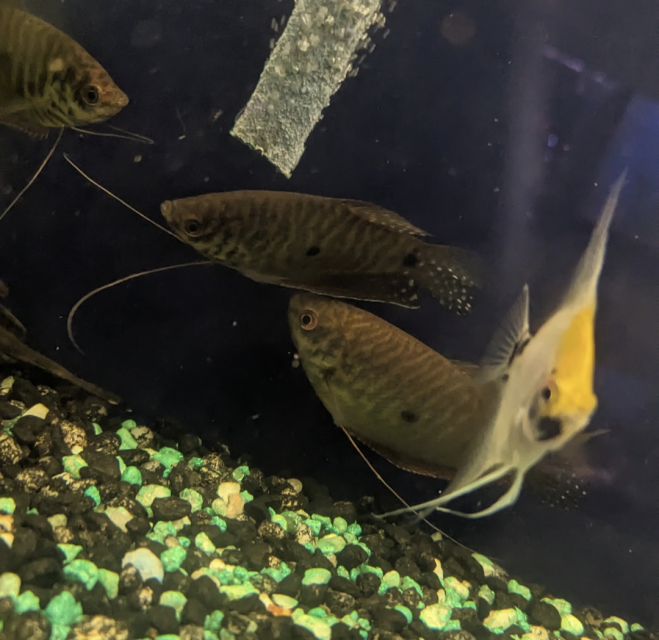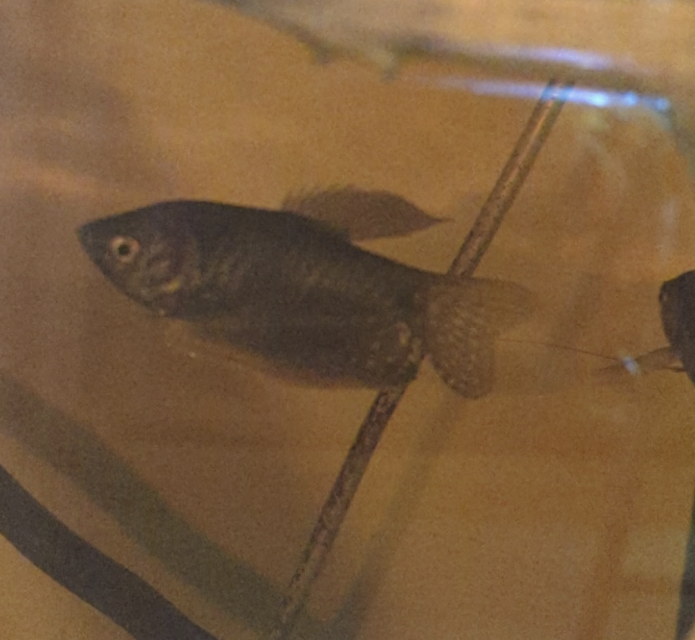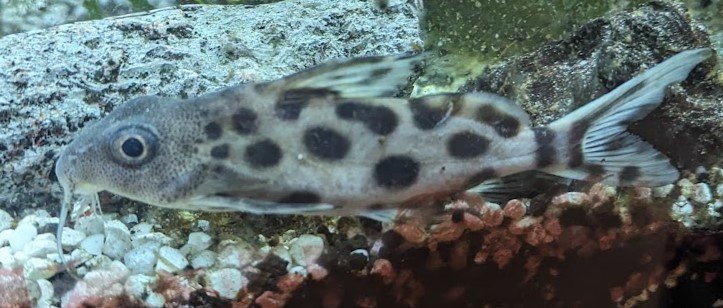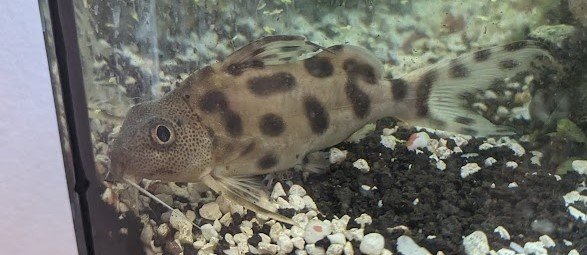Member BAP
Breeders Award Program: Rules, Regulations and Guidelines
You may download the BAP form here
Visit the CCA Forum for the Current Standings
(you must be a member to login)
PURPOSE
ELIGIBILITY
BAP CHAIR AND BAP COMMITTEE
FUNCTIONS OF THE BAP COMMITTEE
BAP CRITERIA AND RULES
POINTS
POINT SCHEDULE FOR CATEGORIES
AWARDS
POINT SCHEDULES
PURPOSE
The Breeders Award Program (BAP) is designed to stimulate interest and foster knowledge in the husbandry of Cichlids. Participation in this program will encourage research into the conservation of the family Cichlidae and recognize the achievements of participating CCA members.
ELIGIBILITY
All members of CCA in good standing may participate in the program.
BAP CHAIR AND BAP COMMITTEE
The CCA President, with the proviso that a five-member committee be formed, shall appoint the BAP Chair. The Chair, with the consent of the Board of Governors, shall appoint the remaining four members. The current CCA President is ex officio a member of the committee.
FUNCTIONS OF THE BAP COMMITTEE
The BAP Committee shall manage and impose the rules and regulations governing the BAP. These duties include verification and awarding of points to the members who have met the criteria, keeping the proper records, and supplying the qualified members with the appropriate awards. The BAP Committee shall periodically review the rules and regulations for possible improvements. The Committee will adhere to the following procedures regarding changes to the rules and regulations.
- A Committee member shall propose a change in writing.
Any CCA member in good standing may propose a change to a Committee member,
who then will propose the change to the Committee.
- The Committee will vote on the proposed change. A majority vote is needed to carry the change.
- The Committee will choose a date for implementation of the change.
- The proposed change, with the effective date, will be published on the CCA website/forum and in the club newsletter.
- Any CCA member in good standing may appeal a BAP Committee decision or ruling. All appeals must be made in writing to the CCA Board of Governors, which, after consultation with the BAP Chair, will make a final decision.
- If a rule/category change results in the reduction of points awarded, the change will not affect previously awarded points. However, if a rule/category change increases the amount of points awarded, the breeder may be eligible for the additional points provided that all other requirements (including any new requirements that may result from the change) are met.
Top of page
BAP CRITERIA AND RULES
In order to qualify for the benefits of the Program, the following criteria have been established:
- For a breeding to be eligible for the BAP, the spawning – defined as the physical mating of fish that produces fertilized eggs – must occur in the tank of the CCA member. Broods that are the result of obtaining eggs or gravid females from another individual, with the fry subsequently being hatched in the member's tank, are not eligible for the BAP.
- No hybrids are eligible. If a hybrid is discovered at a later date, the originally awarded points will be deducted from the member's total and a 10-point penalty will be assessed.
- Fish have been divided into 2 groups, Old World and New World . Each of these groups has been further divided into 4 categories based on ease or difficulty in breeding a certain species or group of fish.
- For any Category A fish, a minimum of 6 fry must be raised for 60 days after hatching, or release of fry in the case of mouth brooding fish. For all other fish, a minimum of 3 fry must be raised for 60 days.
- Verification:
- All BAP spawns are subject to 2 checks.
- First check can be made, in person (at the breeders house) by any current member of the CCA, by emailing a photo of the fry to a BAP Committee member, or by posting a photo (in the BAP Participants area) on the Forum.
- Second check must be made, approximately 60 days after the spawn, by a BAP Committee member. This can either be done at the breeder's house or, the appropriate minimum amount of fry can be brought to a regularly scheduled CCA meeting for verification.
- The Bap Chair or Committee members may not verify their own spawns.
- It is the breeder's responsibility to assure his/her points have been properly verified and reported, to the BAP Committee, by filling out the required spawning report form and acquiring the required signatures for verification.
- Completed BAP forms should be submitted within 90 days of the spawning.
- No points will be awarded for any fish not on the species list until the BAP Committee determines the point category for this fish. The points will be held until this determination is made. The BAP Committee will place the fish on the list within 60 days.
- Any new varieties developed exclusively by a CCA member (i.e., albino forms, long-finned forms, etc.) will be awarded bonus points not to exceed double the original point value of that species. The new line must be standardized and accepted into the hobby to be valid.
- Family memberships will have their points awarded to the family. Individual memberships will have points awarded to the individual.
- The BAP Chair will maintain the official record of BAP standings. These standings can also be posted on the CCA website, in the CCA Forum, and in the Biotope.
Top of page
POINTS
Once the above criteria are met, the CCA breeder will be awarded points according to the following point schedule.
Point Schedule for Categories:
Category A: 10 points - easy to breed.
Category B: 20 points - more challenging because of greater aggression or size, or diet or water quality requirements.
Category C: 30 points - demanding to breed. These fish require specific maintenance conditions in regards to water parameters, aggression control, and/or diet. They are typically considered "rare or uncommon."
Category D: 50 points - most demanding. These fish are rarely bred and require great effort on the part of the breeder due to their size, sensitivity to water conditions and quality, and/or specialized dietary requirements.
Bonus Points:
- First to breed.
- The first CCA member to breed a species will be awarded bonus points equal to the number normally awarded for that fish. For example, the first member to breed a specific Category A fish will receive the standard 10 points plus an additional 10 points for being the “first to breed”.
- A spawn that is recognized as the first breeding of a species in the United States will be awarded the normal points plus a bonus of 50 points.
- “First to breed” points can be held for 90 days if there is a question as to which member was the first to spawn a specific fish. The BAP Chair will determine the recipient of these points.
- Endangered Species.
- A CCA member who breeds any species recognized as endangered in the wild or that is included in a Species Survival Program will be awarded 25 bonus points. Breeder will then be awarded 5 bonus points for each successful spawn thereafter (maximum of 5 spawns).
- Public Presentations.
- A CCA member who auctions off the fry from a successful spawn will be awarded points equal to the category of the species. The fish must be of decent size, about 1”, and in good health. The BAP Chair reserves the right to refuse any fish deemed undersized, in poor health or deformed. All normal rules of the Auction/Mini-Auction will apply. Please designate on the bag and auction form that these fish are eligible for BAP points.
- A CCA member who provides a written account of a successful breeding that is published in The Biotope or other cichlid/aquarist publication will be awarded 25 bonus points.
- A CCA member who makes a formal presentation at a CCA meeting or event, regarding his or her experience with a successful breeding will be awarded 10 bonus points.
AWARDS
- Achievement Level Awards.
- BAP Awards will be presented to CCA members who attain the following levels of breeding achievement:
- Breeder (Level 1) – 70 points (minimum of 5 species) – Club announcement
- Breeder (Level 2) – 150 points (minimum of 10 species) - Certificate
- Intermediate Breeder (Level 1)– 250 points (minimum of 15 species) - Certificate
- Intermediate Breeder (Level 2)– 350 points (minimum of 20 species) - Certificate
- Advanced Breeder (Level 1) – 500 points (minimum of 35 species) - Certificate
- Advanced Breeder (Level 2)– 1000 points (minimum of 50 species) - Plaque
- Master Breeder – 1500 points (minimum of 75 species) - Plaque
- Grand Master – 2000 points (minimum of 100 species) – Plaque & bonus award*
*Bonus award to be determined by BAP Committee
- Special Awards
- Annual Top Breeder Award. A Certificate will be awarded, each year, to the CCA member who has accumulated the most BAP points during the year. “The year” will be defined as the 12 months between the annual December meetings (Holiday party).
- Rarity Breeding Award. On occasion, and with the consent of the current CCA President (or Vice-President, should the President be under consideration for the award), the BAP Committee may elect to recognize a singular breeding achievement by a CCA member. That member shall receive a special certificate recognizing his or her achievement.
Top of page
POINT SCHEDULE
Category A - 10 Points
Old World
Alticorpus
Astatoreochromis
Astatotilpia
Aulonocara
Chilotilapia
Corematodus
Cynotilapia
Genyochromis
Gephyrochromis
Haplochromis sp.
Hemichromis **
Iodotropheus
Labeotropheus **
Labidochromis
Lamprologus brevis
Lamprologus multifasciatus
Lamprologus similis
Lamprologus sp. margarae
Lethrinops
Lichnochromis
Melanochromis
Metriaclima
Neochromis
Neolamprologus tetracanthus
Neolamprologus brichardi
Neolamprologus pulcher
Paralabidochromis
Pelvicachromis pulcher
Petrotilapia
Pseudocrenilabrus
Pseudotropheus
Pundamilia
Pyxichromis
Thoracochromis
Tilapia
Trematocranus
NEW WORLD
Aequidens sp. (The Blue and Green Acaras)
Archocentrus centrarchus
Bujurquina sp.
Cichlasoma sp. (The Black Acaras)
Cryptoheros altoflavus
Cryptoheros myrnae
Cryptoheros nanoluteus
Cryptoheros nigrofasciatus
Cryptoheros panamensis
Cryptoheros sajica
Cryptoheros septemfasciatus
Cryptoheros sp. "Honduras Red Point"
Cryptoheros spilurus
Geophagus sp. **
Guinacara sp.
Gymnogeophagus sp. **
Herichthys carpintis
Herichthys cyanoguttatus
Herotilapia multispinossa
Krobia sp.
Laetacara sp. (curviceps, dorsigerus)
Nannacara sp.
Neetroplus nematopus
Rocio octofasciata
Thorichthys meeki
Top of page
Category B - 20 points
Old world
Altolamprologus calvus
Altolamprologus compressiceps
Altolamprologus fasciatus
Aristochromis
Aulonocranus
Benitochromis
Buccochromis
Callochromis
Cardiopharynx
Chalinochromis
Chromidotilapia
Copadichromis
Ctenochromis
Cyprichromis
Cyrtocara
Didmidiochromis
Diplotaxodon
Docimodus
Eretmodus
Grammatotria
Greenwoodochromis
Haplochromis ahli
Haplochromis bethicola
Hemichromis elongates
Hemichromis fasciatus
Interochromis
Julidochromis
Katria
Labeotropheus marmalade cat
Labeotropheus trewavasae orange x orange
Lamprologus (lake species) **
Lepidiolamprologus
Limnochromis
Limnotilapia
Mbipia
Microdontochromis
Nanochromis
Neolamprolgus **
Nimbochromis
Orthochromis
Otopharynx
Paracyprichromis
Paratilapia
Pelvicachromis **
Placidochromis
Protomelas
Ptychochromis
Ptychochromoides
Rhamphochromis
Sciaenochromis
Spathodus
Steatocranus
Tanganicodus
Telmatochromis
Tropheops
Tylochromis
Tyrannochromis
Variabilichromis
Xenotilapia spilopterus
Xenotilapia flavipinnis
New World
Australoheros ('Cichlasoma' facetum )
Amphilophus citrinellus
Amphilophus labiatus
Amphilophus longimanus
Amphilophus macracanthus
Amphilophus trimaculatum
Apistogramma sp.
Apistogrammoides
exCichlasoma altomaculatum
exCichlasoma salvini
exCichlasoma uropthalmus
Cleithacara maronii
Herichthys bartoni
Heros sp.
Hypselecara sp.
Hypsophrys nicaraguensis
Mesonauta festivum
Microgeophagus altispinosa
Microgeophagus ramerezi
Parachromis freidrichsthalli
Parachromis loiselli
Parachromis managuensis
Parachromis motaguensis
Paratheraps bifasciatum
Paratheraps breidorhi
Paratheraps guttalatus
Paratheraps hartwegi
Paratheraps synspilus
Paratheraps zonatus
Pterophyllum scalare (1 domestic variety)
Thorichthys affinis
Thorichthys aureum
Thorichthys maculipinnis
Thorichthys helleri
Thorichthys pasionis
Thorichthys socolofi
Vieja argentea
Vieja heterospila
Vieja regani
Top of page
Category C - 30 Points
Old World
Asprotilapia
Baileychromis
Bathybates
Champsochromis
Cunningtonia
Cyphotilapia
Ectodus
Etroplus
Gnathochromis
Haplotaxodon
Hemibates
Hemitilapia
Lamprologus (all riverine)
Lestredea
Lobochilotes
Neolamprologus nigriventris
Neolamprologus sexfasciatus (gold)
Neolamprologus tretocephalus
Petrochromis trewavasae
Petrochromis famula
Plecodus
Serranochromis
Simochromis
Stigmatochromis
Trematocara
Tropheus
Xenotilapia **
New World
Amphilophus alfari
Amphilophus altifrons
Amphilophus amarillo
Amphilophus bussingi
Amphilophus calobrensis
Amphilophus diquis
Amphilophus hogaboomorus
Amphilophus lyonsi
Amphilophus margaritifer
Amphilophus nourissati
Amphilophus rhytisma
Amphilophus robertsoni
Amphilophus rostratus
Amphilophus sagittae
Amphilophus xiloaensis
Amphilophus zaliosus
Archocentrus spinosissimus
Astronatus sp.
Batrachops sp.
Caquetaia sp.
Chuco godmanni
Chuco intermedium
Chuco microthalmus
Cichla sp.
exCichlasome Beani
exCichlasome Bocourti
exCichlasoma festae
exCichlasoma grammodes
exCichlasoma islantum
exCichlasoma ornatum
exCichlasoma tuyrense
Crenicara sp.
Crenicichla sp.
Dicrossus sp.
Geophagus crassilabrus
Geophagus surinamensis var.
Gymnogeophagus gymnogenys
Gymnogeophagus labiatum
Gymnogeophagus lacustrus
Herichthys deppii
Herichthys labridens
Herichthys minkleyi
Herichthys pantostictus
Herichthys steindachneri
Nandopsis haitiensis
Nandopsis ramsdeni
Nandopsis tetracanthus
Parachromis dovii
Paraneetroplus bulleri
Paraneetroplus gibbiceps
Paraneetroplus neubuliferum
Paraneetroplus omonti
Paratheraps fenestratus
Paratheraps melanurus
Petenia splendida
Pterophyllum scalare
Satanoperca leucosticta
Satanoperca pappaterra
Symphysodon sp. (1 domestic, 2 F0 wild)
Taeniacara candidi
Teleocichla sp.
Theraps coeruleus
Theraps irregulare
Theraps lentiginosus
Theraps wesseli
Thorichthys callolepis
Tomacichla asfraci
Tomacichla seiboldi
Tomocichla tuba
Uaru amphiacanthoides
Vieja maculicauda
Vieja pearsi
Vieja ufermanni
Top of page
Category D - 50 Points
Old World
Benthochromis
Boulengerochromis
Cyathopharynx
Neolamprologus sexfascitus (blue)
Ophthalmotilapia
Paretroplus
Perissodus
Petrochromis **
Reganochromis
Triglachromis otostigma
New World
Acarichthys heckelii
Acaronia sp.
Biotoecus sp.
Biotodoma sp.
Chaetobranchopsis sp.
Chaetobranchus sp.
Hoplarchus psittacum
Pterophyllum altum
Retroculus sp.
Satanoperca acuticeps
Satanoperca daemon
Satanoperca Lilith
Symphysodon discus Heckel
Catfishes - 10 Points
All catfish species
NOTE: ** = Not All Species
Top of page
|







